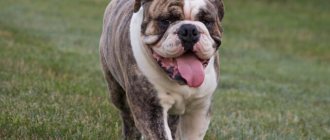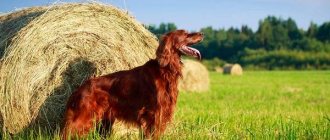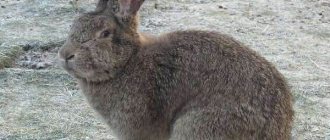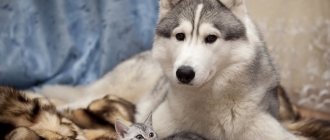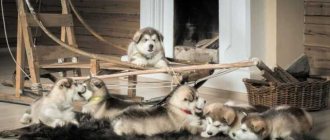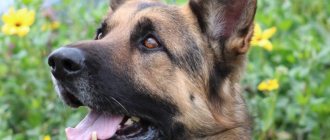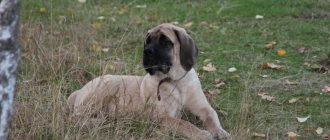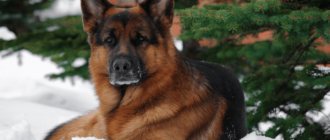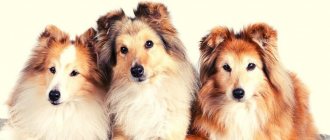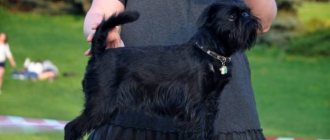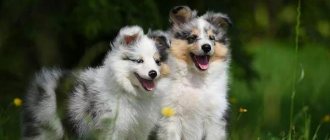Giant rabbits earned their nickname due to their impressive dimensions - the size and body weight of adult rabbits significantly exceed standard indicators, which directly affects their productivity. The advantages of giants also include high fertility and good vitality.
Breeding giants is more profitable, since they are almost 2 times larger in weight and size than their ordinary relatives
From our article you will learn how to properly care for representatives of large breeds of rabbits.
History of the breed
The history of long-eared giants began in the 16th century, in East Flanders. In the city of Ghent, a hybrid was obtained from local and imported breeds - the Flemish rabbit, which in our time is called “Flanders”, “Belgian giant” or “Flemish giant”. The first reliable record of this breed was made in 1860. The breed standard was published in 1893.
Gray giant rabbit
The rabbit from Flanders initially showed little interest to European rabbit breeders. In the 1900s, rabbit breeding began to develop at an accelerated pace. In 1909, more than 70 million rabbit carcasses and skins were sold. A rabbit boom began, which reached its apogee after the end of the First World War.
The giant, bred in Belgium, has become a sought-after breed. They obtained meat and skin from him. Flanders helped feed and warm the population of Europe. In addition, purebred Flemings became the founders of other meat and all-purpose breeds.
Until now, Flemish giants are kept mostly in the countries of Central and Northern Europe. Practical farmers value the unpretentiousness of animals, their adaptability to cold winters, and resistance to disease. Giants require more food, but these costs are offset by the greater weight of the animals.
In Russia, the history of rabbit breeding goes back 9 centuries. Peasants kept rabbits on their farms, but the animals did not have any noticeable impact on the overall supply of people with meat and fur raw materials. Since the 1920s, rabbit breeding in the USSR began to take on industrial features.
In the late 1940s, the gray giant rabbit . After 20 years, the Soviet chinchilla breed appeared. Both breeds were based on the genes of Flemish rabbits. The chinchilla bred in the Union and the gray giant are achievements of domestic breeders, which are still used by Russian and European farmers.
Description and characteristics of the breed
The standard of the breed is the Flanders. Giants are rabbits with strong bones and a long and powerful body. The line of the back, running from the shoulders to the wide croup, has the shape of an arch. It is sometimes compared to a mandolin.
Flanders giant rabbit
The large head is crowned with long ears that are set vertically. When viewed from the front, the ears may flare at the top, taking on a "V" shape. The length of the ears can reach up to 18 cm. Prominent ears and a massive body are the calling card of the breed.
The giant's record weight exceeds 20 kg with a body length of 1.3 m. The average figures are lower: body length 65 cm, weight 8 kg. The breed of giants has changed little over the 2 centuries of its existence. Breeders have significantly expanded the list of colors that the animal’s cover can be painted in.
The American Rabbit Breed Association (ARBA) standard recognizes 7 different colors for this breed: black, steel, light gray, blue, fawn, sand and white. Most often, the giant rabbit in the photo is a steel-gray giant.
Signs of breed quality
When assessing the merits of an animal, experts turn to the breed standard, which provides coefficients. They indicate how important a particular parameter is. For the continental giant, the list of odds looks like this:
- Body structure, proportions, type: 20.
- Weight characteristics: 10.
- Head and ear shape: 20.
- Cover quality: 25.
- Color correspondence to breed characteristics: 20.
- General conditions: 5.
The standard briefly describes what the basic parameters of the breed should be.
- Body structure. A large rabbit gives the impression of a strong animal. The minimum body length is 65 cm. The back is well developed, rising from the neck to the rounded croup. The lower line of the body should not be arched like a hare. The limbs are strong.
- Weight. An adult animal must weigh at least 7 kg.
- Head and ears. The head is big. The muzzle is elongated. The eyes are bright and wide open. The cheeks are thick. The ears are large, held vertically, their tips are rounded. The length of the ear is about 25% of the total length of the body, but not less than 16 cm.
- Cover. Directed backwards, shiny and dense. The length of the main hair is up to 4 cm. The undercoat is abundant, dense, soft to the touch.
- Fur color. Determined by the breed standard. Continental giants are divided into white and colored.
- General conditions. The animal’s behavior and cover should not raise doubts about its state of health.
Homemade
Representatives of domestic breeds of rabbits can be kept both on the street (for the sake of meat and fur) and at home - in a special cage. Animals can freeze outside in cool weather. The home cage is lined with sawdust or straw, which is changed regularly. Animals are not allowed to walk around the apartment! It happily chews furniture upholstery, wires and other interior items. Rabbits of these breeds can be trained to defecate in a tray with a special filler.
Butterfly. This English breed was originally considered a decorative breed. Later representatives of the breed were crossed with Flanders and Viennese Blues. Hybrids are grown for their skins.
Adults have a compact body with a small head and short erect ears. Body length 56-58 centimeters. The chest and back are wide. The limbs are long. The skeleton is strong with well-developed muscles. The fur is short and thick. The main color of the skin is white. A characteristic feature is the presence of black-brown spots. The nose, ears and scruff are black. There is a dark stripe in the center of the back. Weight up to 4.5 kilograms or more. The female is fertile, bringing up to 8 babies in one litter.
The Viennese Blue is the result of crossing the Flanders and Moravian Blue breeds. This hybrid can be classified as an endangered species.
Photo - Vienna Blue
The body is folded proportionally. The head is neat with straight ears rounded at the ends. The back is wide. The body is medium in size with a rounded croup. Limbs are straight and strong. The fur is thick, uniformly colored bluish-blue. The inner surface of the ears is light. Average weight 4.5 kilograms. The female gives birth to up to 9 babies in one litter. The breed is valued for its high fluff content - the skin is extremely delicate and soft.
The main difference is the long ears that hang down freely. The length of such unusual ears is from 18 to 72 centimeters. The size of adult individuals can be either miniature or large. The body is compact, the limbs are short. The color depends on the specific species. There are black, blue, spotted, red and other colors. The length and thickness of the fur also varies depending on the species. Large representatives weigh from 4 to 8 kilograms. They are raised for their skins and meat. The weight of dwarf species averages from 1.5 to 3 kilograms. Such animals are kept in apartments as pets.
The ermine breed comes from England. It was brought to our country at the beginning of the last century.
The body of adults is short (up to 52 centimeters). The head is round with erect ears. Chest circumference 29-34 centimeters. The back is arched, the croup is rounded. Limbs are straight. The fur is thick. The main body color is white. The tip of the nose, paws, ears and tail are black or brown. Average weight is from 3 to 4 kilograms. The female brings up to 8 babies per litter. The breed is unpretentious to living conditions. Valued for its beautiful fur. To improve the appearance of the animals, they are bathed with the addition of a special shampoo.
The Soviet Marder was created by crossing two breeds: Ermine and Chinchilla.
Body length in adults is up to 50 centimeters. The chest is wide, measuring 31 centimeters. The limbs are dense and relatively short. The head is small with erect ears. The fur is short and thick. Body color is brownish. The paws, muzzle, back and tail are always of a darker shade. Average weight is from 3 to 4.2 kilograms. The female gives birth to 7 babies per litter. The fur of adult animals has a high fluff content.
The Rex breed appeared as a result of a natural mutation of Flandres.
The body of adults is compact with a rounded croup. The head is small. A characteristic difference is an underdeveloped mustache. They are much shorter than any other breed. The ears are fleshy and erect. Limbs of medium length. Weight from 3 to 5 kilograms. The fur is thick and dense, but very short (plush). Curly hairs are found only on the nape and belly. The color is chestnut or brown with lighter spots. The breed is valued for its beautiful skin. The animals are distinguished by their playfulness and affectionate disposition. They are often kept in apartments as pets.
Kinds
There are several breeds considered giants.
- The Belgian giant is rabbit . All modern giant rabbits descended from this breed. Bred in Belgium, in the province of East Flanders. He is often called "Flanders", "Flemish giant".
Due to its docile nature, the rabbit received the nickname “gentle giant.” Flandre provides meat and skin for people, which is why it is called the “universal rabbit.” The record weight of the animal is 22 kg, the average is 7 kg.
Belgian giant rabbit
- White giant rabbit . German and Belgian livestock breeders began breeding this breed. Albinos were selected among the Flanders. The necessary qualities were secured through inbreeding. The result was animals with thin bones and high quality flesh. In the 1920s, white rabbits came to the USSR.
Domestic livestock specialists began to improve the breed. They crossed giants with native animals. We obtained a frost-resistant breed with high immunity and survival rate of young animals. Rabbits have high-quality meat and a snow-white coat with elastic, shiny hair. On average, the animal weighs 6.5 kg. Later, on the basis of the white giants, the Soviet chinchilla and other breeds were bred.
White giant rabbit
- Gray giant . Obtained by hybridizing local outbred animals and Flanders rabbits. The birthplace of the breed is the Ukrainian SSR, the Petrovsky animal farm. In 1952, work on breeding gray giants was completed. The usual weight for the breed is 5 kg. In peasant farms, with good care, rabbits eat up to 7 kg.
- The British Giant is a little-known breed outside of England. His origins are not simple. Among the Flanders bred in England, only the steel color was considered normal. In the 1940s, giants with coats of different colors were brought to the shores of Foggy Albion from the States. From them the British giants were bred.
- The Spanish giant is a breed that is in danger of extinction. Obtained as a result of hybridization of the white giant with Spanish native breeds.
- German giant . The breed is sometimes called the German Riesen. Received from Flandre. One of the best hybrids of grand size. It grows to 65-79 cm in length. It can weigh 12 kg.
- Hungarian giant or Hungarian agouti. A breed that has existed for about 200 years. An adult individual gains weight up to 7 kg. The Hungarian giant is gradually being replaced by modern, more productive species of rabbits.
- Continental giant . German giants brought to England from local rabbit breeders were called “continental”.
There is still confusion in terms. Some rabbit breeders consider the continental giant to be an independent breed, others perceive this name as a synonym for the German giant, while others use the name “continental” to mean all European giant rabbits.
Giant ram rabbit
- Ram is a breed bred by English rabbit breeders in the 19th century. Spread quickly in Europe. Through the efforts of breeders, varieties were obtained that can be called giants. The average weight of German and French sheep is 9 kg.
Pros and cons of the breed
When figuring out the positive and negative qualities of rabbit varieties, it is worth looking, first of all, at the orientation of the breed. All giants are universal rabbits. This has its advantages.
- The giant rabbit breed is a source of meat and skin. Both products are of good quality.
- Quality is accompanied by quantity - there is a lot of meat, the skin is large.
- Fertility in animals is at a high level. An adult rabbit gives up to 6 litters per year. Males are not lazy and actively participate in reproduction.
- Giants are caring parents. Females do not abandon their babies and successfully feed their offspring.
Risen rabbit is the size of a dog
Many people believe that giants have no disadvantages. But if desired, negative qualities can include:
- The large size of animals requires large cage dimensions.
- Giant rabbits eat a lot. But experience shows that the amount of feed per unit of weight consumed is the same as in other breeds.
Rabbits are record holders
Among the large breeds there are representatives that have received recognition for various records. The most famous is the current record holder named Ralph. The animal has the weight of a 3-year-old child and lives as a pet in one of the British families.
His age is 4 years old, but he has already received the title of the largest and fattest rabbit in the world. Its weight is more than 22 kg, its length is more than 1 meter. This animal has a good pedigree, since its parents at one time earned the title of the largest on the planet.
However, this animal for some time lost its records, which were broken by another of its relatives - the rabbit Darius, who was included in the Guinness Book of Records in 2010. But Ralph regained his achievement when he overtook Darius in height. Other record holders are also known in the world: Roberto, Alice and Amy. Each individual listed weighed more than 10 kg.
Care and maintenance
The cage is the main home of rabbits. The dimensions of a giant rabbit suggest a cage of appropriate dimensions: 1.8 m at the end, 1 m deep, 0.7 m high. Such a cage can comfortably accommodate a female with her offspring. For single rabbits, smaller cages are built: 1-1.2 m wide, 0.75 m deep, 0.45-0.6 m high.
The cages are placed in a barn, on 2 floors or in a shed (under a canopy). In any case, direct sunlight should not enter the rabbit's house. In addition to ultraviolet radiation, rabbits should be protected from drafts. Giants are very sensitive to dampness and cool breezes.
Giant breed cage
Giants are sedentary rabbits. Most of the time they lie in the corner of their home. To prevent muscle atrophy, it is advisable to take them out of the cage for a few minutes every day and force them to move a little.
Cage designs for large rabbit farms and small peasant farms are similar to each other. What truly sets professional rabbit breeders apart is regular veterinary care. The larger the farm, the more dangerous any infection. The vaccination plan includes vaccinations against rabies, myxomatosis, rabbit viral hemorrhage, and so on.
Professional livestock breeders strictly adhere to the vaccination plan. It is not customary for gardeners and farmers who keep a small number of rabbits to contact veterinarians. If infection is suspected in a given area, the entire population of rabbits is usually slaughtered. Next, the cages are cleaned and disinfected, new young animals are purchased, and the livestock is quickly restored.
Diseases
Giant rabbits often suffer from all sorts of diseases. The greatest danger for them is represented by diseases of infectious etiology, which can destroy their entire population within a few days.
These diseases are represented by:
- infectious rhinitis;
- pesterellosis;
- fascioliasis;
- tularemia;
- myxomatosis;
- listeriosis.
Non-communicable diseases are represented by:
- pneumonia;
- rhinitis;
- diseases of the gastrointestinal tract, accompanied by bloating and constipation.
Worms
Giant rabbits often suffer from helminthic infestations. Affected animals, which have lost their appetite, rapidly lose weight, suffer from diarrhea and, if not treated immediately, can die very quickly.
If a sick rabbit comes into contact with other animals, there is a high probability of infection of the entire livestock. Treatment of helminthiasis consists of regular disinfection of the cage, taking naphthamon and homeopathic medicines.
Fleas
To rid your rabbit of these parasites, you need to bathe him using a special shampoo.
Ringworm
Scaly pink spots appear on the skin of a rabbit affected by ringworm, and bald spots appear on the fur in these places.
Treatment of the disease consists of lubricating the lesions with salicylic alcohol or iodine solution. At the end of the treatment procedure, a small amount of heated fish oil is applied to the affected areas.
Stomatitis
A rabbit that has contracted stomatitis suffers from pain in the mouth due to the presence of ulcers localized on the tongue.
As a result, he refuses to eat and is in a lethargic state. To cure the animal, regular treatment of the oral cavity with a 2% solution of copper sulfate is necessary.
Diseases of the gastrointestinal tract
This group of diseases makes itself known by bloating, diarrhea, the presence of mucus in the stool, and the depressed state of the animal. The first stage of treatment consists of following a daily fasting diet.
After this time, the rabbit is given freshly prepared soft food. For diarrhea, the rabbit is given a teaspoon of oak bark decoction. To eliminate bloating, you need to give the animal a 10% ichthyol solution (1 teaspoon).
Rhinitis
The clinical manifestations of this disease are the same as in humans: the rabbit sneezes, mucus flows from its reddened nose. To prevent a runny nose from triggering the development of pneumonia, a 1% solution of furatsilin must be instilled into each nasal passage of the animal for two weeks.
Prevention measures
To prevent the development of diseases, the rabbit breeder must:
- create comfortable living conditions for animals;
- promptly remove spoiled feed and stagnant water;
- keep the dishes from which pets are fed clean;
- provide ventilation for the rabbitry;
- carry out regular replacement of litter;
- from time to time disinfect the premises in which animals are kept;
- regularly examine both baby and adult rabbits;
- exclude the possibility of birds and mice, which are the main carriers of dangerous infections, entering cages with rabbits;
- Vaccinate your pets promptly.
Nutrition
Starting in early spring, young dried greens are introduced into the animals’ diet. Leaves and stems of lilies of the valley, milkweed, and henbane are excluded from green fodder and harvested hay. In addition to hay, branches of birch, aspen, and coniferous trees are prepared for winter.
In winter, animals chew up all the food prepared in summer. It takes extra energy to stay warm. The owners feed their charges with crackers. Increase the amount of vegetable mash in the rabbits’ diet. The giants are fed in the afternoon. Their diet includes the usual components for rabbits:
- dried grass in summer, hay, twig food in winter;
- compound feed;
- grain mixtures with the addition of legumes;
- mineral ingredients;
- mash (mixture of chopped vegetables).
The feeding rules are simple. You cannot use spoiled, low-quality, or stale products. In winter, make sure that the water and mash do not freeze. In summer, remove leftover food. Keep the water clean. The diet of giants differs little from the food that other breeds receive. The giants are given more food; the protein ingredients in their diet are increased, that is, they are given more legumes.
In general, rabbits are not picky and are content with rough food. Pregnant females receive additional rations. In summer they eat up to 700 g of grass and approximately 100 g of concentrated feed. In winter - 200 g of hay, 160 g of concentrated feed, 250 g of succulent feed (vegetables). Lactating rabbits eat one and a half times more. As the rabbits grow, the portion of females increases.
Do not overfeed the animal. The amount of food should be adequate to its size and condition. Excess food and an immobile life lead to obesity, which is associated with numerous pathologies.
When young animals are 3-4 months old, a decisive moment in their lives begins. Further maintenance becomes economically unprofitable. More feed is spent per 1 kg weight gain than at an early age. Therefore, 4-month-old rabbits, for the most part, are released for sale or slaughter.
Nuances of feeding
Another important point in care is adjusting the animals’ nutritional diet. You should not feed giant rabbits spoiled, moldy and expired food and waste. It is better to purchase special food from a pet store, which is selected individually for each breed. It will help maintain a normal balance of nutrients.
During the summer, rabbits can be given fresh grass. However, excessive consumption of vegetation can lead to diarrhea and increased gas production in giant rabbits. To prevent problems, the greens need to be dried for several days. Experts strongly do not recommend giving wet plants to rabbits.
Reproduction and lifespan
Giants of all varieties are characterized as caring and fertile parents. Breeding giant rabbits is not difficult. Males older than 6-7 months and females 6 months old are allowed to mate.
To obtain higher quality offspring of Flemish giants, it is recommended not to rush into the first mating. Wait until the female gains adult weight. No earlier than 8 months of age should a male be allowed near her.
While awaiting the appearance of offspring, females build a nest in advance. They rarely refuse to perform maternal responsibilities. Female rabbits are fertile, giving birth to an average of 7-8 babies. It happens that females give birth to 15 or more cubs.
Rabbit with grown-up rabbits
The survival rate of babies reaches 90%. Females are attentive to the rabbits. They are rarely trampled despite their clumsiness, significant weight and size. Baby rabbits grow quickly. A week after birth, babies begin to grow down. On the 10th day, the eyes open. After 2 weeks, the bravest ones leave the nest for a while.
The weight of a newborn rabbit rarely exceeds 90 g. After a week, their weight doubles. When a baby rabbit is one month old, it is 10 times heavier than its starting weight. Young giants grow most actively up to 4 months. They reach adult size at 8 months of age.
The life of a giant rabbit is not very long. At 4 months of age it can be slaughtered for meat. If the rabbit is lucky, he will spend 4-5 years in a cage. Among animals there are long-livers, for which the limit comes at 6-8 years.
Breeding
Gray giants are classified as high fertility breeds. Individuals who have reached sexual maturity are allowed to mate: in males it occurs at the age of 6–8 months, in females – at 5.5–6 months. Overweight rabbits are not used for mating, as they are less fertilized and are not able to produce healthy offspring.
Gray “giants” are quite prolific; in one litter they can produce up to 14 rabbits
For mating, the female rabbit and male rabbit are placed in a common cage, having previously freed it from unnecessary objects (feeders, drinking bowls). After mating, they are seated in separate rooms. After 3-4 hours, mating is repeated.
Pregnancy lasts 28-30 days. About a week before giving birth, the female begins to pluck her fur, arranging a nest for her future offspring. Four days before birth, the baby rabbits begin to move inside the mother's belly. Typically, the number of rabbits in one litter ranges from 8 to 14. Gray giant females are caring mothers with high milk production, which allows them to feed all the offspring.
In the following video you can observe the behavior of the rabbit and her cubs:
Price
Active retail and small wholesale trade in live rabbits is facilitated by the spread of animals. The average price of a giant rabbit when purchased individually is 400 rubles. The price range is quite wide - from 300 to 1000 rubles.
The price of rabbit carcasses depends little on the breed that was slaughtered for meat. Averages 300-400 rubles per kg. Suppliers do not even indicate what breed is slaughtered. Which is not entirely correct. The quality of the pulp is highest in meat breeds, slightly lower in meat-skin breeds, i.e., in giants, and even lower in skin-bearing breeds. Of all the breeds, only giants can be identified from the carcass, due to their outstanding size.
conclusions
- Giant rabbits are capable of gaining a large mass in a short time, most of which is pure meat.
- In order for this to be possible, it is necessary to provide the animals with a sufficient amount of high-quality food, a spacious, warm and dry room.
- Rabbits must be bred taking into account the need to prevent inbreeding.
- The choice of breed must be made based on the goals and available resources.
- For young animals, it is necessary to carry out timely vaccinations and preventive measures against common infections.

